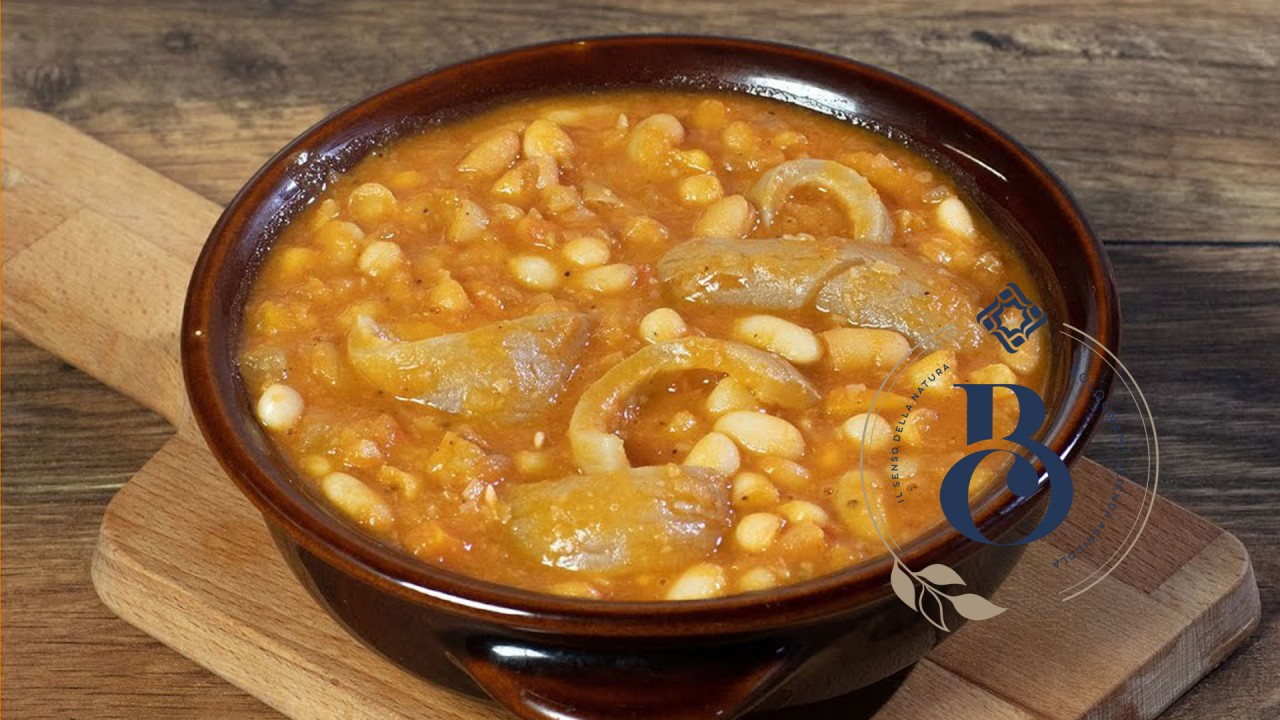
Fagioli con le Cotiche
I Fagioli con le Cotiche sono un tipico piatto del Centro Italia, l'origine della ricetta è praticamente sconosciuta, l'Umbria e il Lazio sene contendono la paternità da sempre. Comunque, l'importante è che siano stati creati, per me sono una grande specialità, è una di quelle ricette che non vedo l'ora di preparare. La tradizione prevede che si faccia da Dicembre a Marzo ma per me va bene per tutto l'anno, basta che ho a disposizione gli ingredienti giusti. Della ricetta ne esistono diverse varianti che si distinguano per piccoli particolari, questa di Bolognami è la ricetta della mia famiglia da sempre
Fagioli con le Cotiche Ricetta Tradizionale Umbra
La ricetta dei Fagioli con le Cotiche si perde nella notte dei tempi, sicuramente la sua storia viene dai contadini dell'Umbria e del Lazio, che avevano a disposizione i semplici ingredienti che compongono la ricetta già in casa. Le Cotenne del maiale c'erano perché conservate sotto sale oppure erano quelle del prosciutto messe da parte durante l'avviatura, i Fagioli erano quelli dell'orto, e qui nasce una grande disquisizione. Io preparo i Fagioli con le Cotiche con i Cannellini come si fa nella mia zona e in mote zone del Lazio, ma in certe zone dell'Umbra come in alcune del Lazio si prepara con i Fagioli Borlotti, ritengo che essendo fondamentalmente una zuppa i Cannellini siano più adatti, ma comunque in questi casi molto dipende dal proprio gusto. Oggi, per rendere la ricetta molto più leggera, si adoperano le Cotenne Fresche del Maiale e la mia ricetta prevede anche di adoperare il Capocollo fresco invece della pancetta stagionata, comunque la ricetta rimane sempre buonissima
Ingredienti per Preparare i Fagioli con le Cotiche
500 Gr di Fagioli Cannellini Bolognami
300 Gr di Cotenne Fresche di Maiale Sgrassate
300 Gr di Capocollo Fresco di Maiale
1 Cipolla
1 Carota
1 Costola di Sedano
4-6 Pomodori Pelati
Olio Extra Vergine di Oliva Santa Margherita Bolognami
6 Foglie di Salvia
Vino Bianco Poggio la Macchia Duca della Corgna 2018
Pepe Nero di Kampot Bolognami, Quanto Basta
Fior di Sale di Trapani Bolognami
Come si Preparano i Fagioli con le Cotiche
Per prima cosa mettiamo i Fagioli Cannellini a bagno per 12 Ore. Iniziaomo con lessare le Cotenne di Maiale in abbondante acqua salata con la Carota, il Sedano e la Cipolla, scolatele al dente perché devono finire la loro cottura nel sugo, fatele freddare e se c'è bisogno sgrassatele ancora, tagliatele a listarelle e mettetele da parte. Preparate anche il Capocollo e tagliatelo a listarelle. Schiacciate bene i Pomodori Pelati riducendoli in poltiglia. Lessate i Fagioli in abbondante acqua salata insieme a due foglie di Salvia, mi raccomando non usate quella rimasta dall'ammollo, scolateli al dente, e non buttate l'acqua di cottura. Preparate il soffritto l'Olio Extra Vergine di Oliva Santa Margherita Bolognami, la Cipolla, il Sedano e la Carota, appena la cipolla diventa trasparente aggiungete le Cotenne e il Capocollo, mettete quattro foglie di Salvia e appena bolle sfumate con il Vino Bianco Poggio la Macchia Duca della Corgna, dosate di sale e di pepe, appena la parte alcolica è evaporata aggiungete il Pomodoro. Fate asciugare e aggiungete e fagioli con un po di acqua di cottura, fate bollire il dai 10 ai 20 minuti, il tutto non deve diventare una poltiglia ma deve essere una zuppa densa. Assaggiate e se c'è bisogno dosate nuovamente di sale e pepe. L'acqua di cottura dei Fagioli non la buttare perché se non li finite subito vi servirà per renderli morbidi il giorno dopo. Buon Appetito. Mamma mia che goduria
Vino Consigliato per i Fagioli con la Cotiche
Consiglio un Vino BIanco come il Poggio la Macchia Duca della Corgna che è prodotto con uve 100% Grechetto, e nasce dalla selezione e raccolta manuale dei migliori grappoli di una piccola vigna del conprensorio del Trasimeno per una media annua di 3500 bottiglie. Vista l'età del vigneto e la sua grandezza siamo ca. 55/60 q.li/HA. di Uva raccolta annua per un 30 hl/HA di vino prodotto, con questa etichetta la cantina ha voluto proporre una piccola selezione del territorio di Castiglione del Lago. Dopo la raccolta iniziano con la diraspatura e la pigiatura delle uve appena giunte in cantina. Il mosto viene fatto fermentare insieme alle bucce per circa 20 giorni e, dopo la svinatura, viene favorita la fermentazione malolattica. Affinato per 10 mesi in botte grande, come da tradizione, trascorso questo periodo viene imbottigliato dove trascorre circa un anno in bottiglia. Nel Bicchiere si presenta di colore giallo paglierino brillante, al naso sprigiona profumi complessi, tipici del vitigno, che spaziano dalle note agrumate di cedro, alla ginestra e alla frutta tropicale. In bocca è secco e ben strutturato. Dotato di una naturale freschezza, gode di una buona persistenza finale. Deve essere servito a una temperatura di 14 Gradi































































































Lascia un Commento